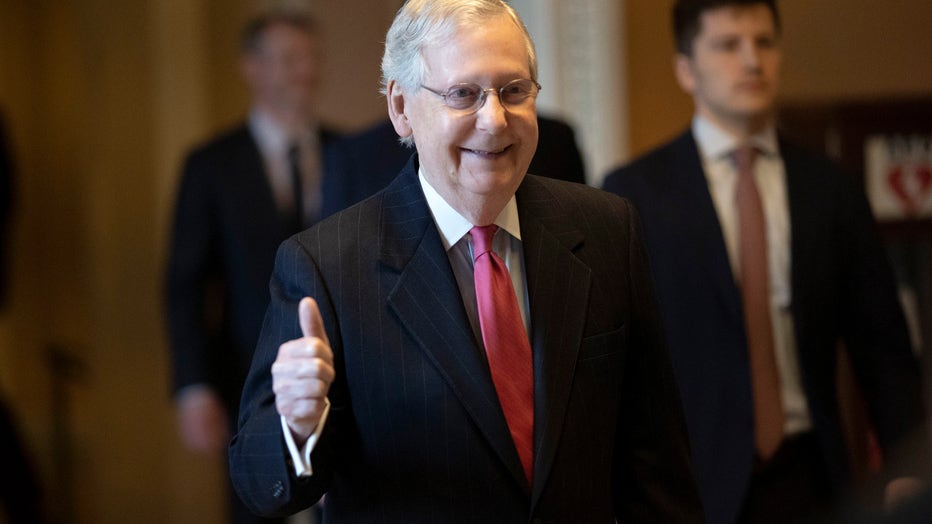Here’s what’s in the COVID-19 stimulus bill and who qualifies to get money
WASHINGTON (AP) - The Senate passed a mammoth $2.2 trillion economic rescue package steering aid to businesses, workers and health care systems engulfed by the coronavirus pandemic, an unprecedented response amid record new jobless claims and mounting evidence that the economy is in a recession.
The unanimous Senate vote late Wednesday came despite misgivings on both sides about whether it goes too far or not far enough and capped days of difficult negotiations as Washington confronted a national challenge unlike it has ever faced.
The House of Representatives is expected to vote on and pass the package on Friday. Here’s everything you need to know about the COVID-19 relief aid:
Keeping small business in business
The sprawling, 500-page-plus measure builds on efforts focused on vaccines and emergency response, sick and family medical leave for workers, and food aid.
It would give direct payments to most Americans, expand unemployment benefits and provide a $367 billion program for small businesses to keep making payroll while workers are forced to stay home.
RELATED: 'The whole city laid off': US jobless claims climb sky high amid coronavirus crisis
One-time checks to Americans
The measure would provide a quick, one-time stipend of about $1,200 per individual, $2,400 for couples, and $3,000 for family of four. The money would cut off at higher income levels.
The bill says that the payment is reduced by five percent of every dollar above that mark, or $50 for every $1,000 above $75,000.
RELATED: Do you qualify for a stimulus check in Senate's coronavirus response bill?
What that ultimately means is that for people who make more than $75,000 the payment is less the higher their earnings are, with it being reduced to zero for those who make $99,000 or more.
Payments, according to the bill, will be made “as rapidly as possible” and no later than Dec. 31, 2020. Though the language of the bill requires that the checks be distributed by Dec. 31, 2020, officials have said that the aim is to have money in Americans' pockets much faster, likely in the coming weeks.
The payments will be made via direct deposit to an account that the person has authorized for tax refunds or federal payments on or after Jan. 1, 2018.
Notice will be sent to the person’s last known address within 15 days of payment informing them of the method and amount of payment. A phone number will also be provided so people can call the IRS in the event they did not receive it.

U.S. Senate Majority Leader Mitch McConnell (R-KY) gives a thumbs up sign after speaking on the floor of the U.S. Senate on March 25, 2020 in Washington, DC. ((Photo by Win McNamee/Getty Images))
Unemployment expansion
Establishes a new, much more generous unemployment benefit by adding $600 per week to normal state benefits for up to four months and provides an additional 13 weeks of benefits to 39 weeks of regular unemployment insurance through the end of 2020 if they are sidelined by the outbreak. The coverage would be retroactive to Jan. 27. Extends coverage to “gig” workers and independent contractors.
RELATED: CDC’s ‘flatten the curve’ graphic shows why social distancing amid coronavirus pandemic is necessary
Funding public health
The bill includes an additional $242 billion in additional emergency appropriations to fight the virus and shore up for safety net programs. That includes money for food stamps, child nutrition, hospitals, the Centers for Disease Control and public health and transportation agencies. The figure has gone significantly higher during talks over the weekend.
The measure includes $15.6 billion to augment the food stamp program, which helps feed around 40 million Low income people per year. It’s annual budget is around $70 billion. A bipartisan package is likely to provide far more.
RELATED: Stay at home: These states have issued orders for residents not to go out amid COVID-19 pandemic
Industry aid
The initial GOP plan called for $208 billion in loans to larger businesses like airlines, which would have to be repaid, and a subsequent; a version released over the weekend called for $500 billion. Leaders are still negotiating the final number and how the money would be provided by the administration and safeguards to prevent abuses. Delays payroll tax payments by employers. They would would be able to defer payment of their 2020 payroll taxes until 2021 and 2022.
State aid
Republicans and the administration have resisted demands by Democrats and governors for aid to the states, whose governors have requested $150 billion to shore up budgets strained by large new costs and plummeting tax revenues. Negotiations are likely to produce a compromise.
FOX News contributed to this report.

